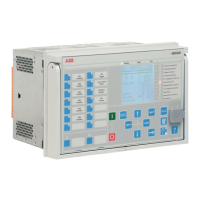U
A
U
B
U
C
I
A
I
B
I
C
U
A
U
B
U
C
I
A
I
B
I
C
A
B
-I
C
I
B
- I
c
-90°
U
1
U
1
Figure 159: Phasors in a single-phase earth fault, phase A to ground, and a two-
phase short circuit, phases B-C, are short-circuited when the polarizing quantity is
the positive-sequence voltage U 1
Network rotation direction
Typically, the network rotatiion direction is counterclockwise and defined as "ABC".
If the network rotation direction is reversed, meaning clockwise, that is, "ACB", the
equations for calculating the angle difference need to be changed. The network
rotation direction is defined with a system parameter
Phase rotation
. The change
in the network rotation direction affects the polarization method of the phase-to-
phase voltages where the calculated angle difference needs to be rotated 180
degrees. Also, when the sequence components are used, the calculation of the
components is affected but the angle difference calculation remains the same.
The sequence components are the positive-sequence voltage or negative-sequence
voltage components. When the phase-to-ground voltages are used as the polarizing
method, the network rotation direction change has no effect on the direction
calculation.
The network rotation direction is set in the IED using the parameter in
the HMI menu Configuration > System > Phase rotation. The default
parameter value is "ABC".
Protection functions 1MRS757644 H
314 620 series
Technical Manual

